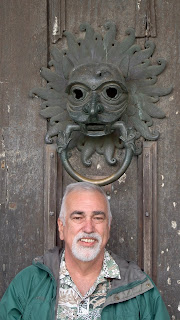I do
enjoy an English country garden and the one at Belsay Hall in Northumberland is
no exception. The house itself is
unfurnished and maintained in a benign state of decay which is in itself quite
fascinating. The space is used for
exhibitions during the warmer months, something which simply wouldn’t be
practical for the rest of the year unless ice sculptures were on display.
The
gardens are lovely and I do delight in both the familiar and the
unfamiliar. Fuchsias do particularly
well in the North unlike in our own garden in the Heights-of-Hornsby so that aspect
itself had the potential to keep me occupied for hours whilst waiting patiently
for a native red squirrel to scamper by which one eventually did.
 |
| Belsay Hall Garden - Northumberland |
Once
common throughout the UK, the Victorians introduced North American Grey
Squirrels to the British Isles for reasons best known to themselves. They were rather fond of altering entire landscapes
and it would seem the ecosystems therein as well. The large and more robust squirrellpox
carrying Grey Squirrel has now completely dominated its Red cousin and there is
little chance of reversing that situation.
Somewhat
closer to Lin’s house we took a thorough wander around the town of Bishop Auckland. Bishop has been previously memorable for my
visits to Morrisons Supermarket and I do love a good supermarket. But now I’ve scoped the railway station, the high
street with its statue of famous one-time resident Stan Laurel as well as the
castle which was home to the prince bishops who once rule over whole swathes of
the North-East. This was a kind of
weird-arsed ecclesiastical oligarchy, not too dissimilar to what’s currently
evolving in America only the bishops were generally much more benevolent than the televangelists
and mega-church MAGAs of the United States and not nearly as greedy. There is even a body of evidence which
suggests that at least a few of the bishops may have actually been Christians.
 |
| Snake-oil salesman & "christian" oligarch Kenneth Copeland |
Then
there’s the new tower which is a recent addition to the heritage precinct and
dare I say something of an assault upon it which is apt given that it’s
supposed to evoke the idea of a medieval siege engine. What I saw was the head fame of a mine shaft
which made perfect sense given the coal mining history of the North although not exactly where it is. Anyway, the view from 15m up is
great and you can even see Lin’s house.
There is a gallery and museum below and it’s provided the town with a
function space but the architect will be long dead when people are still saying
“Christ that’s bloody ugly!”
 |
| Bishop Auckland Tower |
Recharged
after a relatively easy day in and around Bishop Auckland we took on the
cobblestones of Durham which is a truly lovely city and England’s third
university town after Oxford and Cambridge with an academic tradition that
dates back almost as far. Durham is
extremely wanderable although not entirely sciatica-friendly because of the
aforementioned cobblestones which proliferate.
A walking stick and the occasional sit helped immensely though and the
sits were a good chance to take in the atmosphere of the place.
 |
| Glenn at the door of Durham Cathedral |
The first
time we visited Durham five years ago I imagined it to be at the confluence of
two rivers but the River Wear, pronounced Weir upon which there's an actually weir (weird eh?!) meanders in
a tight horseshoe through the town giving the impression of two rivers rather
than just one. The castle and ancient
cathedral could easily consume a day themselves and then you’d need another to
poke about the streets and shops, the indoor marketplace and nearby town hall
but we did it all in a day with time out for the Lebanese lunch I’d been
craving since flying over the Middle East several weeks earlier.
 |
| The weir of the Wear pronounced weir |





No comments :
Post a Comment